
The Great Northern Railway (GNR) was a British railway company incorporated in 1846 with the object of building a line from London to York. It quickly saw that seizing control of territory was key to development, and it acquired, or took leases of, many local railways, whether actually built or not. In so doing, it overextended itself financially.
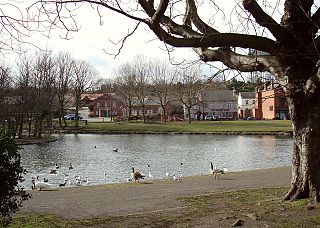
Askern is a town and civil parish within the City of Doncaster, in South Yorkshire, England. It is on the A19 road between Doncaster and Selby. Historically part of the West Riding of Yorkshire, it had a population of 5,570 at the 2011 Census. Askern was also known in for its Greyhound Stadium, which closed in 2022.

The East Coast Main Line (ECML) is a 393-mile long (632 km) electrified railway between its southern terminus at London King's Cross station and Edinburgh Waverley via Peterborough, Doncaster, York, Darlington, Durham and Newcastle. The line is a key transport artery on the eastern side of Great Britain running broadly parallel to the A1 road. The main line acts as a 'spine' for several diverging branches, serving destinations such as Cambridge, Leeds, Hull, Sunderland and Lincoln, all with direct services to London. In addition, a few ECML services extend beyond Edinburgh to serve Glasgow Central, although the principal London-Glasgow route is the West Coast Main Line (WCML).
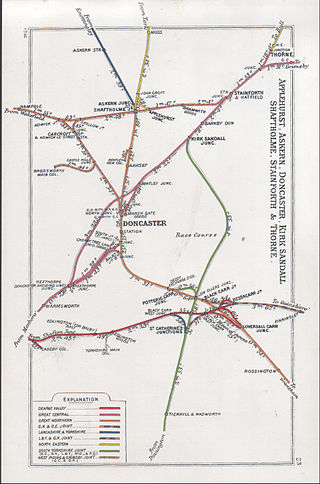
The South Yorkshire Joint Railway was a committee formed in 1903, between the Great Central Railway, the Great Northern Railway, the Lancashire and Yorkshire Railway, the Midland Railway and the North Eastern Railway to oversee the construction of a new railway in the Doncaster area of South Yorkshire, England. The five companies had equal rights over the line, each of the companies regularly working trains over it.

The Sheffield–Lincoln line is a railway line in England. It runs from Sheffield to Lincoln via Worksop, Retford and Gainsborough Lea Road. The route comprises the main line of the former Manchester, Sheffield and Lincolnshire Railway (MS&LR), to Gainsborough Trent Junction, where it then follows the former Great Northern and Great Eastern Joint Railway (GNGEJR) to Lincoln Central. The former MS&LR main line continues from Trent Junction to Wrawby Junction, Barnetby, much of it now single line, where it then runs to Cleethorpes. In 2023, the Department for Transport announced that a new station will be opened on the line. Waverley station will be located between Darnall and Woodhouse.

Knottingley railway station serves the town of Knottingley in West Yorkshire, England. It lies on the Pontefract Line, operated by Northern, and is 16 miles (26 km) south east of Leeds railway station.
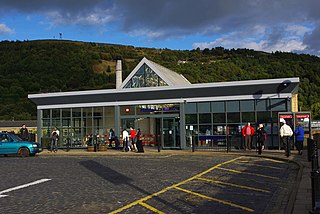
Halifax railway station serves the town of Halifax in West Yorkshire, England. It lies on the Calder Valley line and is 17 miles (27 km) west from Leeds.

Selby railway station is a Grade II listed station which serves the market town of Selby in North Yorkshire, England. The original terminus station was opened in 1834 for the Leeds and Selby Railway. The Hull and Selby Railway extended the line in 1840 and a new station was built, with the old station becoming a goods shed. The station was rebuilt in 1873 and 1891; the 1891 rebuilding was required due to the replacement of the swing bridge over the River Ouse at the same time.

Church Fenton railway station serves the village of Church Fenton in North Yorkshire, England. It is situated where the Cross Country Route from Leeds to York meets the Dearne Valley line from Sheffield to York, just under 10.75 miles (17 km) from York.
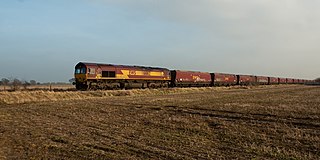
The Askern branch line is a railway line which runs in North, South and West Yorkshire in England. The stretch of track runs from Shaftholme Junction north of Doncaster, via Askern, Norton and Womersley to Knottingley, where it joins the Pontefract Line.

Askern railway station was a station on the Askern branch line of the former Lancashire & Yorkshire Railway between Doncaster and Knottingley. It served the town of Askern in South Yorkshire, England.

Joan Croft Halt railway station was a small halt on the East Coast Main Line (ECML) situated by a level crossing at Joan Croft Junction in South Yorkshire, England. The junction gives access from the ECML to the Skellow line of the West Riding and Grimsby Railway and eventually to Hull, Immingham and Grimsby Docks.
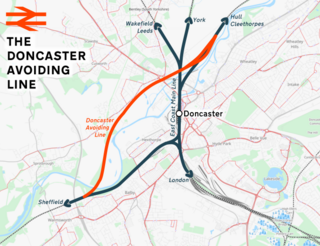
The Doncaster Avoiding Line is a railway line, which as its title suggests, avoids the town of Doncaster and routes goods traffic, principally coal and steel, away from the main line station where it would have to cross from the Sheffield line to the Hull or Cleethorpes lines and cause a bottleneck.
The Freight Route Utilisation Strategy is a Route Utilisation Strategy in the United Kingdom, published by Network Rail in March 2007. It is one of only two which have the perspective of the network as whole. It was included in a map published by the Office of Rail Regulation (ORR) as established in May 2007. As with other RUSs, the Freight RUS took into account a number of responses to a Draft for Consultation, including those from the ORR.
The East Coast Main Line Route Utilisation Strategy (RUS), published by Network Rail in February 2008, was the seventh RUS.

The Selby Diversion is a mainline railway in the United Kingdom, built as a new part of the East Coast Main Line (ECML) to avoid an area of potential subsidence over the newly discovered Selby Coalfield.

Dukeries Junction, originally Tuxford Exchange, was a railway station near Tuxford, Nottinghamshire, England. The station opened in 1897 and closed in 1950. It was located at the bridge where the Lancashire, Derbyshire and East Coast Railway crossed over the East Coast Main Line (ECML), with sets of platforms on both lines. The high-level location is now part of the High Marnham Test Track.

The South Humberside Main Line runs from Doncaster on the East Coast Main Line to Thorne where it diverges from the Sheffield to Hull Line. It then runs eastwards to Scunthorpe and the Humber ports of Immingham and Grimsby, with the coastal resort of Cleethorpes as terminus.
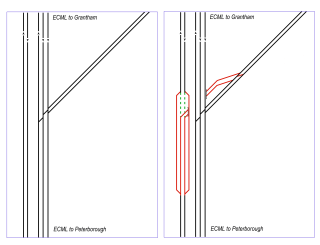
Werrington Dive Under is a replacement dual track grade separated railway junction at Werrington Junction, 3 miles (5 km) north of Peterborough railway station in Cambridgeshire, England. The junction leads to the Great Northern/Great Eastern Joint line (GN/GE) which goes through Spalding to Lincoln and beyond. Completed and opened in December 2021, the dive under allows trains on the west side of the East Coast Main Line (ECML) to access the GN/GE line without conflicting with the faster passenger services on the ECML.
The Great Northern Railway developed an extensive network over time, having started in 1846 with the intention of connecting London and York, as well as other major Yorkshire towns. The Great Northern Railway in Yorkshire was a major part of that, although the GNR did not succeed in reaching York as it originally intended. By acquiring running powers it reached Leeds, Bradford and Halifax over other companies' lines, as well as Barnsley Sheffield and Grimsby, and then York too. After acquiring local companies it developed a network, chiefly in West Yorkshire. Later it built lines north and west of Bradford into hilly terrain, and these were very expensive to build, and never repaid the initial cost.

















